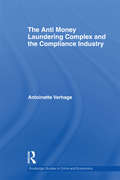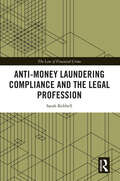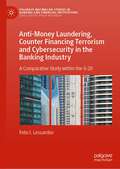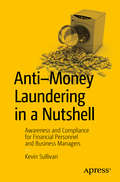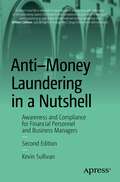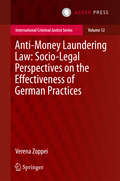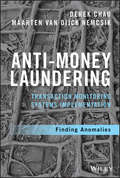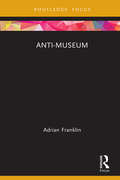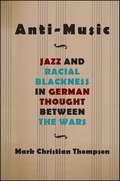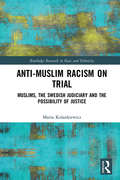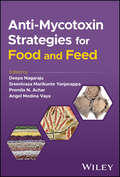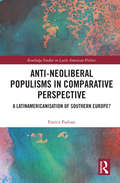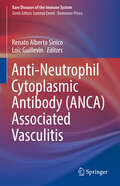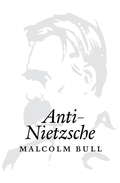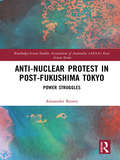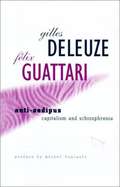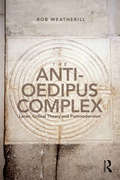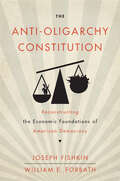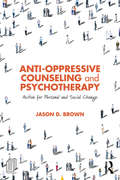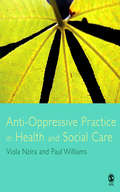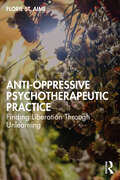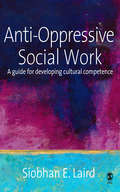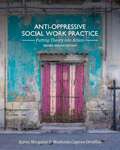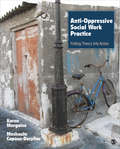- Table View
- List View
The Anti Money Laundering Complex and the Compliance Industry (Routledge Studies In Crime And Economics Ser. #3)
by Antoinette VerhageFinancial institutions, as gateways to the financial system, to economic power and possibilities, are one of the major vehicles for money laundering and therefore also represent an important means to prevent this type of crime. The compliance officer symbolises a part of this private investment in anti money laundering (AML) and as a bank employee is responsible for the implementation of governmental objectives, trapped between crime fighting objectives and commercial goals. The duality of the involvement of private partners in the AML complex and the vastness of the system serves as a background for a new book looking at the functioning, values and perceptions of actors within this system. With thorough analysis of original empirical date, Verhage provides a rich and illustrative insight in the world of compliance officers and the sometimes paradoxical AML system that they have to work within.
Anti-Money Laundering Compliance and the Legal Profession (The Law of Financial Crime)
by Sarah KebbellMoney laundering is a global issue and there is evidence that the services provided by the legal profession may be misused to launder the proceeds of crime. This book explores the experiences of professionals within Top 50 law firms when seeking to comply with the UK’s anti-money laundering (AML) regime. The book draws upon empirical evidence from 40 in-depth interviews with solicitors and compliance personnel from 20 Top 50 law firms. Access to this section of the legal profession is challenging in the context of academic research, and the research provides an account, seldom heard in academic literature, directly from practitioners. The book uses these research findings to explore and discuss the AML compliance issues faced by this section of the profession. It highlights the challenges presented by the legislative architecture of the Proceeds of Crime Act 2002, and considers compliance issues relating to customer due diligence, AML training, the client account and the suspicious activity reporting regime. It also considers participants’ perceptions of the regime, their role within it, and their own assessment of money laundering risk. It concludes by using this evidence to recommend amendments to current AML policy and legislation. This book will be of interest to students and researchers studying Financial Crime Law, Business and Company Law, and White Collar Crime, as well as policy makers in the areas of money laundering, compliance, and corruption.
Anti-Money Laundering, Counter Financing Terrorism and Cybersecurity in the Banking Industry: A Comparative Study within the G-20 (Palgrave Macmillan Studies in Banking and Financial Institutions)
by Felix I. LessamboDespite massive investments in mitigation capabilities, financial crime remains a trillion-dollar global issue with impacts that extend well beyond the financial services industry. Worldwide, there are between $800 billion and $2 trillion laundered annually with the United States making up at least $300 billion of that figure. Although it is not possible to measure money laundering in the same way as legitimate economic activity, the scale of the problem is considered enormous. The cybersecurity landscape is always shifting, with threats becoming more sophisticated all the time. Managing risks in the banking and financial sectors requires a thorough understanding of the evolving risks as well as the tools and practical techniques available to address them. Cybercrime is a global problem, which requires a coordinated international response. This book outlines the regulatory requirements that come out of cyber laws and showcases the comparison in dealing with AML/CFT and cybersecurity among the G-20, which will be of interest to scholars, students and policymakers within these fields.
Anti-Money Laundering in a Nutshell: Awareness and Compliance for Financial Personnel and Business Managers
by Kevin SullivanAnti-Money Laundering in a Nutshellis a concise, accessible, and practical guide to compliance with anti-money laundering law for financial professionals, corporate investigators, business managers, and all personnel of financial institutions who are required, under penalty of hefty fines, to get anti-money laundering training. Money laundering is endemic. As much as 5 percent of global GDP ($3. 6 trillion) is laundered by criminals each year. It''s no wonder that every financial institution in the United States--including banks, credit card companies, insurers, securities brokerages, private funds, and money service businesses--must comply with complex examination, training, and reporting requirements mandated by a welter of federal anti-money laundering (AML) laws. Ignorance of crime is no excuse before the law. Financial institutions and businesses that unknowingly serve as conduits for money laundering are no less liable to prosecution and fines than those that condone or abet it. In Anti-Money Laundering in a Nutshell: Awareness and Compliance for Financial Personnel and Business Managers, Kevin Sullivan draws on a distinguished career as an AML agent and consultant to teach personnel in financial institutions what money laundering is, who does it, how they do it, how to prevent it, how to detect it, and how to report it in compliance with federal law. He traces the dynamic interplay among employees, regulatory examiners, compliance officers, fraud and forensic accountants and technologists, criminal investigators, and prosecutors in following up on reports, catching launderers, and protecting the integrity and reputations of financial institutions and businesses. In particular, corporate investigators will gain rich insights winnowed from the author''s experiences as a New York State and federal investigator. What you''ll learn US federal and international AML laws The AML measures and program that financial institutions must have in place to control money laundering, such as KYC, CIP, and AML/CFT risk assessment The practical steps that personnel at every level from the teller window to the C-suite must know to ensure institutional compliance with AML regulations, such as filling out SARs and CTRs Who this book is for Under federal acts such as the Bank Secrecy Act of 1970, the Money Laundering Suppression Act of 1994, and the Intelligence Reform and Terrorism Prevention Act of 2004, every financial institution in the United States must have an anti-money laundering program in place that includes annual training of all relevant employees. This short book is an educational text or supplemental reader for such training by anti-money laundering compliance officers, examiners, agents, and consultants. Table of Contents Chapter 1. What is Money Laundering? Chapter 2. Methods of Money Laundering Chapter 3. Federal Regulations Chapter 4. Building a Quality AML Program for Financial Institutions Chapter 5. Know Your Customer and Customer Identification Program Chapter 6. A SAR Is Born Chapter 7. Money Laundering for Law Enforcement Chapter 8. International Standards Chapter 9. FRAML Glossary Appendix A: Red Flags Appendix B: Code of Federal Regulations Title 31 Section 103. 18
Anti-Money Laundering in a Nutshell: Awareness and Compliance for Financial Personnel and Business Managers
by Kevin SullivanAnti–Money Laundering in a Nutshell is a concise, accessible, and practical guide to compliance with anti–money laundering law for financial professionals, corporate investigators, business managers, and all personnel of financial institutions who are required, under penalty of hefty fines, to get anti–money laundering training. This new edition of Anti-Money Laundering will update the topics discussed, and introduce the changes and updates including information on the AMLA Act of 2020, new EU standards and directives, anti-money laundering on digital currencies and more.Money laundering is endemic. As much as 5 percent of global GDP ($3.6 trillion) is laundered by criminals each year. It’s no wonder that every financial institution in the United States—including banks, credit card companies, insurers, securities brokerages, private funds, and money service businesses—must comply with complex examination, training, and reporting requirements mandated by a welter of federal anti–money laundering (AML) laws. Ignorance of crime is no excuse before the law. Financial institutions and businesses that unknowingly serve as conduits for money laundering are no less liable to prosecution and fines than those that condone or abet it.In Anti–Money Laundering in a Nutshell: Awareness and Compliance for Financial Personnel and Business Managers, Kevin Sullivan draws on a distinguished career as an AML agent and consultant to teach personnel in financial institutions what money laundering is, who does it, how they do it, how to prevent it, how to detect it, and how to report it in compliance with federal law. He traces the dynamic interplay among employees, regulatory examiners, compliance officers, fraud and forensic accountants and technologists, criminal investigators, and prosecutors in following up on reports, catching launderers, and protecting the integrity and reputations of financial institutions and businesses. In particular, corporate investigators will gain rich insights winnowed from the author's experiences as a New York State and federal investigator.
Anti-money Laundering Law: Socio-legal Perspectives on the Effectiveness of German Practices (International Criminal Justice Series #12)
by Verena ZoppeiIn the aftermath of recent multiple leaks such as the Panama Papers, the Swiss leaks, and the Bahama leaks, this book offers an interesting view on the underlying conflicting interests that impede the adoption of more effective legislation to stop money laundering by way of the financial system. The central position of the book is that the declared goals underlying the criminalization of money laundering have not been fulfilled. The effectiveness of the anti-money laundering regime in Germany is assessed by examining the indirect effects, collateral consequences, and positive interpretations of the law in action and of the law inaction; reducing the issue to a question of symbolic effectiveness does not reflect the complexity of the matter. What is demonstrated, is that the goals attributed to the regime were too ambitious, and that a lower degree of effectiveness has been accepted in order to balance the inherent political, economic and financial conflicting interests. Unlike other volumes focusing on this issue, this book deals with the implementation of the legislation and the consequences thereof, and is primarily aimed at legal sociologists, sociology of law researchers, criminal lawyers, criminologists with an interest in white collar crime and political scientists studying measures against illicit financial flows and the concrete implementation of anti-money laundering laws. The book will also be of interest to policymakers and consultants, as well as policymakers and consultants at a German level for instance working on improving the instruments to fight organized crime and preventing the financing of terrorism through money laundering. The complexity of the anti-money laundering regime and all the variables are exhaustively and critically reviewed in the assessment, thereby providing complete instructions for future legislative steps. The case study regarding the situation in Germany maximizes readers' insights into concrete effects of the implementation of international anti-money laundering standards at a national level, and the opinions of professionals working in the field and of experts on the law-making process are also illumination. Moreover, the book equips non-German speakers with the information needed to deal with the extensive German legal scholarly production on article 261 of the German criminal code and the current internal political debate on the matter.
Anti-Money Laundering Transaction Monitoring Systems Implementation: Finding Anomalies (Wiley and SAS Business Series)
by Derek Chau Maarten van NemcsikEffective transaction monitoring begins with proper implementation Anti-Money Laundering Transaction Monitoring Systems Implementation provides comprehensive guidance for bank compliance and IT personnel tasked with implementing AML transaction monitoring. Written by an authority on data integration and anti-money laundering technology, this book offers both high-level discussion of transaction monitoring concepts and direct clarification of practical implementation techniques. All transaction monitoring scenarios are composed of a few common elements, and a deep understanding of these elements is the critical factor in achieving your goal; without delving into actual code, this guide provides actionable information suitable for any AML platform or solution to help you implement effective strategies and ensure regulatory compliance for your organization. Transaction monitoring is increasingly critical to banking and business operations, and the effectiveness of any given solution is directly correlated to its implementation. This book provides clear guidance on all facets of AML transaction monitoring, from conception to implementation, to help you: Detect anomalies in the data Handle known abnormal behavior Comply with regulatory requirements Monitor transactions using various techniques Regulators all over the world are requiring banks and other companies to institute automated systems that combat money laundering. With many variables at play on both the transaction side and the solution side of the equation, a solid understanding of AML technology and its implementation is the most critical factor in successful detection. Anti-Money Laundering Transaction Monitoring Systems Implementation is an invaluable resource for those tasked with putting these systems in place, providing clear discussion and practical implementation guidance.
Anti-Museum (Museums in Focus)
by Adrian FranklinAnti-Museum charts the development of the anti-museum as a concept and as it has been realised in practice. Drawing on a range of case studies, including the New Museum and PS1 in New York, Mona in Australia, Art42 in Paris and Donald Judd’s Marfa, the book assesses their potential to engage museum publics in new ways. Anti-museums seek to breathe relational and theatricalised vitality into the objects they exhibit, by connecting them to the contexts of their making, to their social life outside the museum, to visitors' lives via their transformative capacities for change, and by being a place of dialogue, exchange and transformation, rather than instruction. Documenting the ways in which they have been created by artists, collectors, and curators, the book also examines the extent to which anti-museums connect with other museums through the exchange of values and resources. Critically, it asks whether, after some 40 years of ‘new museology’, such institutions are still able to offer something fresh and valuable. Anti-Museum provides a sharp and incisive account of the anti-museum as it has been imagined, realised and experienced, and as it has relevance for understanding and working in the contemporary museum world. As such, the book will be of great interest to scholars and students engaged in the study of museums, cultural economy, inclusive urban regeneration, the democratisation of art and contemporary art. It should also appeal to museum professionals around the world.
Anti-Music: Jazz and Racial Blackness in German Thought between the Wars (SUNY series, Philosophy and Race)
by Mark Christian ThompsonAnti-Music examines the critical, literary, and political responses to African American jazz music in interwar Germany. During this time, jazz was the subject of overt political debate between left-wing and right-wing interests: for the left, jazz marked the death knell of authoritarian Prussian society; for the right, jazz was complicit as an American import threatening the chaos of modernization and mass politics. This conflict was resolved in the early 1930s as the left abandoned jazz in the face of Nazi victory, having come to see the music in collusion with the totalitarian culture industry. Mark Christian Thompson recounts the story of this intellectual trajectory and describes how jazz came to be associated with repressive, virulently racist fascism in Germany. By examining writings by Hermann Hesse, Bertolt Brecht, T.W. Adorno, and Klaus Mann, and archival photographs and images, Thompson brings together debates in German, African American, and jazz studies, and charts a new path for addressing antiblack racism in cultural criticism and theory.
Anti-Muslim Racism on Trial: Muslims, the Swedish Judiciary and the Possibility of Justice (Routledge Research in Race and Ethnicity)
by Marta KolankiewiczThis book constitutes a critical engagement with debates on the possibilities and limits of fighting racism with the help of criminal law. With in-depth analyses of cases of anti-Muslim violence in Sweden—a mosque fire, hate speech and of a series of assaults—Anti-Muslim Racism on Trial sheds light on issues central for understanding the ways in which racism is approached in court. It also illustrates the different forms that Islamophobia can take. Departing from a definition of law as a knowledge regime that embodies the power to decide on the meaning of the acts on trial and to establish a valid version of these events, the author explores the possibility of justice and recognition in court. From within a post-Holocaust and post-colonial context, this book recounts the complex and ambiguous history of laws against racism, examining the ways in which racist practices change in a society where certain manifestations of racism have come to be treated as crimes. As such, it will appeal to scholars of sociology and criminology with interests in Islamophobia, race and ethnicity and violence.
Anti-Mycotoxin Strategies for Food and Feed
by Deepa Nagaraju Sreenivasa Marikunte Yanjarappa Premila N. Achar Angel Medina VayaAnti-Mycotoxin Strategies for Food and Feed Up-to-date information on mycotoxigenic fungi and toxins, with methods to control them in food and feed Anti-Mycotoxin Strategies for Food and Feed focuses on strategies to control the health risk of mycotoxins associated with cereals, pulses, and vegetables during post and pre harvest stages, in addition to foods, food-based products, and feeds. Each chapter is carefully designed to offer information elucidating various strategies, which include physical, chemical, and biological methods. The book provides a combined approach of advanced techniques used against mycotoxigenic fungi, which is helpful in studying the strategies for different mycotoxins. Special attention has been paid to diseases caused by mycotoxigenic fungi and their destructive effect on either preharvest, post-harvest, or storage, and their respective toxins which pose a long-term health risk to humans and animals, if contaminated food or feed enter our food chain. The primary focus of the text is on the recent and advanced approaches and strategies including control, detoxification, degradation and binding methods, with graphical representations of protocols with supporting tables and figures. Anti-Mycotoxin Strategies discusses specific sample topics such as: Advanced anti-fumonisin strategies and strategies for the control of aflatoxigenic Aspergillus species in contaminated food and feed Innovative strategies to decontaminate Ochratoxin A and Zearalenone. Effects of toxic citrinin, patulin and Ergot alkaloids in animals, birds, and humans, and effective mitigation strategies as its control measures. Detoxification and Decontamination strategies of Deoxynivalenol an emetic toxin, Trichothecenes, T-2/HT-2 toxin and nivalenol associated in food and feed as contaminants. Presenting and discussing mycotoxin management strategies at length and enabling readers to reduce or eliminate health hazards to humans and animals, Anti-Mycotoxin Strategies is an essential resource for mycologists, mycotoxicologists, Microbiologists, Food technology professionals in the food, seed, and feed industries, scientists, students, researchers, and farmers / agriculturists.
Anti-Neoliberal Populisms in Comparative Perspective: A Latinamericanisation of Southern Europe? (Routledge Studies in Latin American Politics)
by Enrico PadoanIn this book, Enrico Padoan proposes an original middle-range theory to explain the emergence and the internal organisation of anti-neoliberal populist parties in Latin America and Southern Europe, and the relationships between these parties and the organised working class. Padoan begins by tracing the diverging evolution of the electoral Lefts in Latin America and Southern Europe in the aftermath of economic crises, and during the implementation of austerity measures within many of these nations. A causal typology for interpreting the possible outcomes of the realignments within the electoral Lefts is proposed. Hereafter, the volume features five empirical chapters, four of which focus on the rise of anti-neoliberal populist parties in Bolivia, Argentina, Spain and Italy, while a fifth offers an analysis on four ‘shadow cases’ in Venezuela, Uruguay, Portugal and Greece. Scholars of Latin America and Comparative Politics will find Anti-Neoliberal Populisms in Comparative Perspective a highly valuable resource, offering a distinctive perspective on the impact of different populisms on party systems and on the challenges that such populisms posed to syndicalism and to traditional left-of-centre parties.
Anti-Neutrophil Cytoplasmic Antibody (Rare Diseases of the Immune System)
by Renato Alberto Sinico Loïc GuillevinThis volume, written by well-known experts in the field, covers all aspects of Anti-Neutrophil Cytoplasmic Antibody (ANCA) Associated Vasculitis (AAV). The expression refers to a group of diseases, characterized by destruction and inflammation of small vessels. The clinical signs vary and affect several organs, such as the kidney, lung, skin, nervous system and others. The opening chapters give some historical hints, explain the genetic basis of the disease and provide insights into the pathogenesis derived from recent experimental studies and guides the reader through classification and nomenclature. A large part of the book is then devoted to a detailed description of the specific related diseases and their clinical presentations, the disease course, and potential complications. The advice regarding treatment is based on the best currently available evidence in this constantly evolving area. The book is part of Springer’s series Rare Diseases of the Immune System, which presents recently acquired knowledge on pathogenesis, diagnosis, and therapy with the aim of promoting a more holistic approach to these conditions. AAVs are systemic autoimmune diseases of unknown cause that affect small (to medium) sized blood vessels. They include granulomatosis with polyangiitis (formerly Wegener's granulomatosis), microscopic polyangiitis, and eosinophilic granulomatosis with polyangiitis (formerly Churg–Strauss syndrome). This volume will be an invaluable source of up-to-date information for all practitioners involved in the care of patients with these diseases.
Anti-Nietzsche
by Malcolm BullNietzsche, the philosopher seemingly opposed to everyone, has met with remarkably little opposition himself. He remains what he wanted to be-- the limit-philosopher of a modernity that never ends. In this provocative, sometimes disturbing book, Bull argues that merely to reject Nietzsche is not to escape his lure. He seduces by appealing to our desire for victory, our creativity, our humanity. Only by 'reading like a loser' and failing to live up to his ideals can we move beyond Nietzsche to a still more radical revaluation of all values--a subhumanism that expands the boundaries of society until we are left with less than nothing in common.Anti-Nietzsche is a subtle and subversive engagement with Nietzsche and his twentieth-century interpreters--Heidegger, Vattimo, Nancy, and Agamben. Written with economy and clarity, it shows how a politics of failure might change what it means to be human.
Anti-nuclear Protest in Post-Fukushima Tokyo: Power Struggles (Routledge/Asian Studies Association of Australia (ASAA) East Asian Series)
by Alexander James BrownThis book explores the politics of anti-nuclear activism in Tokyo after the Fukushima nuclear disaster of March 2011. Analyzing the protests in the context of a longer history of citizen activism in Tokyo, it also situates the movement within the framework of a global struggle for democracy, from the Arab Spring to Occupy Wall Street. By examining the anti-nuclear movement at both urban and transnational scales, the book also reveals the complex geography of today’s globally connected social movements. It emphasizes the contestation of urban space by anti-nuclear activists in Tokyo and the weaving together of urban and cyber space in their praxis. By focusing on the cultural life of the movement—from its characteristic demonstration style to its blogs, zines and pamphlets—this book communicates activists’ voices in their own words. Based on excellent ethnographic research, it concludes that the anti-nuclear protests in Tokyo after the Fukushima disaster have redefined social movement politics for a new era. Providing an analysis of a unique period in Japan’s contemporary urban history from the perspective of eyewitness observations, this book will be useful to students and scholars of Japanese Politics, Sociology and Japanese Studies in general.
Anti-Oedipus: Capitalism and Schizophrenia
by Gilles Deleuze Félix GuattariThis is an essential text for feminists, literary theorists, social scientists, philosophers, and others interested in the problems of contemporary Western culture.
The Anti-Oedipus Complex: Lacan, Postmodernism and Philosophy
by Rob WeatherillThe Anti-Oedipus Complex critically explores the post ‘68 dramatic developments in Freudo-Lacanian psychoanalysis and cultural theory. Beginning with the decline of patriarchy and the master, exemplified by Freud’s paean for the Father, the revolutionary path was blown wide open by anti-psychiatry, schizoanalysis and radical politics, the complex antimonies of which are traced here in detail with the help of philosophers, such as Nietzsche, Baudrillard, Levinas, Steiner, Žižek, Badiou, Derrida and Girard, as well as theologians, analysts, writers, musicians and film makers. ? In this book, Rob Weatherill, starting from the clinic, considers the end of hierarchies, the loss of the Other, new subjectivities, so-called ‘creative destruction’, the power of negative thinking, revolutionary action, divine violence and new forms of extreme control. The book raises the following questions: Does the engagement of the Radical Orthodoxy movement offer some hope? Or should we re-situate psychoanalysis within a ‘genealogy of responsibility’ (Pato?ka / Derrida) as it emerges out of the sacred demonic, via Plato and Christianity? The Anti-Oedipus Complex will be of interest to psychoanalysts, psychotherapists, counsellors, social workers and scholars in critical theory, philosophy, cultural theory, literary theory and theology.
The Anti-Oligarchy Constitution: Reconstructing the Economic Foundations of American Democracy
by Joseph Fishkin William E. ForbathA bold call to reclaim an American tradition that argues the Constitution imposes a duty on government to fight oligarchy and ensure broadly shared wealth. Oligarchy is a threat to the American republic. When too much economic and political power is concentrated in too few hands, we risk losing the “republican form of government” the Constitution requires. Today, courts enforce the Constitution as if it has almost nothing to say about this threat. But as Joseph Fishkin and William Forbath show in this revolutionary retelling of constitutional history, a commitment to prevent oligarchy once stood at the center of a robust tradition in American political and constitutional thought. Fishkin and Forbath demonstrate that reformers, legislators, and even judges working in this “democracy of opportunity” tradition understood that the Constitution imposes a duty on legislatures to thwart oligarchy and promote a broad distribution of wealth and political power. These ideas led Jacksonians to fight special economic privileges for the few, Populists to try to break up monopoly power, and Progressives to fight for the constitutional right to form a union. During Reconstruction, Radical Republicans argued in this tradition that racial equality required breaking up the oligarchy of slave power and distributing wealth and opportunity to former slaves and their descendants. President Franklin Roosevelt and the New Dealers built their politics around this tradition, winning the fight against the “economic royalists” and “industrial despots.” But today, as we enter a new Gilded Age, this tradition in progressive American economic and political thought lies dormant. The Anti-Oligarchy Constitution begins the work of recovering it and exploring its profound implications for our deeply unequal society and badly damaged democracy.
Anti-Oppressive Counseling and Psychotherapy: Action for Personal and Social Change
by Jason D. BrownIn Anti-Oppressive Counseling and Psychotherapy, Jason D. Brown examines the impact of structural inequality on mental health and provides a framework for an anti-oppressive practice that recognizes privilege and challenges systemic barriers. Incorporating theory, research, and detailed case studies, readers will learn how to implement intervention techniques that take into consideration the diverse social identities of both therapist and client. The text also teaches students and practicing psychotherapists how to use anti-oppressive practices to effect social change within their communities and society at large.
Anti-Oppressive Practice in Health and Social Care
by Paul Williams Viola NziraAnti-Oppressive Practice in Health and Social Care presents a distinctive holistic approach to developing anti-oppressive practice in a range of health and social care settings, and with a range of service users. Drawing on case studies and practice guidelines, the book proposes strategies which students and professionals can use to develop skills in cultural equality and anti-discrimination and apply them to their everyday practice. The book begins with an account of the nature of anti-oppressive practice and goes on to explore the core theories, concepts and strategies of anti-oppressive practice. Key features of the book include: " a positive preventative approach that sets it apart from existing texts in the field " invaluable practical guidance on how to develop and evaluate personal and organisational cultural practice " a number of helpful features, such as annotated case studies which illustrate best practice, cultural competence and common pitfalls. Anti-Oppressive Practice in Health and Social Care is an essential text for all health and social care undergraduates, on such courses as social work, health care, nursing and counselling. It will also be a useful reference tool for qualified practitioners who wish to reflect on their personal and organisational practice.
Anti-Oppressive Psychotherapeutic Practice: Finding Liberation Through Unlearning
by Florie St. AimeThis book supports mental health practitioners in showing how they personally intersect with oppression, helping them explore how it shows up in their practice and providing them with tools to offer anti-oppressive care.Written in an accessible and spiritual tone, chapters discuss the human need for connection as well as demonstrate the oppression through a social, neuroscientific, and biological lens as something that resides and can be passed on generationally. St. Aime interrogates the idea of the moral cloak symbiotic with whiteness and encourages readers to separate themselves from their profession to become a reflective rather than defensive clinician. She defines anti-oppressive practice as a clinical approach that considers the systemic, intergenerational, sociocultural and political influences on the lives of individuals and identifies the pillars of anti-oppressive practice as interconnectedness, interdependence, boundless curiosity, and vulnerability. With chapters including both experimental and practical exercises to use with clients as well as alone, this book encourages clinicians to undergo the process of unlearning the internalized oppressions that exist within themselves to change the therapeutic power exchange and provide the best care possible.This book is essential reading for clinical social workers in practice and in training, as well as for psychotherapists, counselors, marriage and family therapists, and other mental health practitioners.
Anti-Oppressive Social Work: A Guide for Developing Cultural Competence
by Siobhan Laird`This is an exciting and valuable book. In considering the role and importance of cultural competence in professional practice with diverse populations, it provides a refreshing and much needed approach to social work theory and practice' - Kwame Owusu-Bempah, Reader in Psychology, University of Leicester Anti-Oppressive Social Work: A Guide for Developing Cultural Competence aims to improve social work training and practice by arguing that a thorough understanding of people's values, social norms and family arrangements are crucial to achieving culturally sensitive practice. The book moves beyond traditional conceptions of anti-oppressive and anti-racist practice by exploring the cultural heritages of some of the main ethnic minorities living in the United Kingdom, and by identifying the many forms that racism can take. The book includes: " an introduction to the context and history of ethnic minorities living in Britain " a discussion of the nature of racism " individual chapters on: communities with roots in India, Pakistan, Bangladesh, the Caribbean, and China. " a separate chapter on economic migrants, refugees and asylum seekers " a range of practice examples which encourage students and practitioners to identify general principles which underpin cultural competence. Critical, yet acessible, the book opens up possibilities for more culturally aware and more effective social work practice. It will be essential reading for all those training to become social workers as well as practitioners wishing to engage with fresh perspectives on anti-oppressive practice. Siobhan Laird is a lecturer in social work at the University of Sheffield. She has previously worked in practice and academic roles in Northern Ireland and Ghana.
Anti-Oppressive Social Work Practice: Putting Theory into Action
by Moshoula Capous-Desyllas Karen MorgaineAnti-Oppressive Social Work Practice: Putting Theory into Action applies anti-oppressive theories and concepts to a generalist social work practice model to provide students with tools to develop a critically evaluative and self-reflective social work practice. The text combines social welfare history, theory, skills and concrete examples of anti-oppressive practice in real-world settings to help students develop a personal practice that is grounded in an understanding of social justice and the need for social workers to interrogate their work and the institutions that they find themselves working in. <P><P>Opening chapters address social justice, values and ethics, and theory, and challenge students to critically examine their own social positions, identities, and values. Later chapters present fields of social work and social justice practice, from micro through macro, historical and ideological contexts, and a variety of skills and forms of practice. Within each chapter, Stories from the Field provide students with reflections from practitioners and participants on anti-oppressive practice and social justice work, highlighting personal successes and challenges. <P><P>The second edition includes new material on environmental and ecological justice, the ethics of care, feminist theoretical approaches, the non-profit industrial complex and other contemporary topics. This edition also incorporates additional Stories from the Field, an expanded section on tools and approaches to family work, as well as additional supplemental films, readings, and organizational resources. <P><P>Anti-Oppressive Social Work Practice is an ideal text for foundational courses in social work that approach multi-level practice from a decolonizing perspective.
Anti-Oppressive Social Work Practice: Putting Theory Into Action
by Karen L. Morgaine Moshoula J. Capous-DesyllasAnti-Oppressive Social Work Practice is the first text to fully integrate concepts of anti-oppressive practice with generalist practice course content. This comprehensive approach introduces concepts of social justice and offers detailed insight into how those principles intersect with the practice of social work at the micro, mezzo, and macro levels. The book covers ethics, values, and social work theory, and discusses the fundamentals of working with individuals, families, groups, organizations, and communities. The book also highlights policy and social movement activism and practice within a global context. Maintaining an integrative approach throughout, authors Karen Morgaine and Moshoula Capous-Desyllas effectively bridge the gap between anti-oppressive principles and practice, and offer a practical, comprehensive solution to schools approaching reaccreditation under the mandated CSWE Standards. ? “Provides an important step in the ongoing evolution of generalist practice in social work. It continues a rich tradition [that] challenges the profession to become more and more explicit about the revolutionary aspect of practice.” —Christian Itin, Metropolitan State University of Denver “Offers a fresh perspective of social work practice interventions.” —Terrence Allen, North Carolina Central University
Anti-Oppressive Social Work Practice: Putting Theory Into Action
by Karen L. Morgaine Moshoula J. Capous-DesyllasAnti-Oppressive Social Work Practice is the first text to fully integrate concepts of anti-oppressive practice with generalist practice course content. This comprehensive approach introduces concepts of social justice and offers detailed insight into how those principles intersect with the practice of social work at the micro, mezzo, and macro levels. The book covers ethics, values, and social work theory, and discusses the fundamentals of working with individuals, families, groups, organizations, and communities. The book also highlights policy and social movement activism and practice within a global context. Maintaining an integrative approach throughout, authors Karen Morgaine and Moshoula Capous-Desyllas effectively bridge the gap between anti-oppressive principles and practice, and offer a practical, comprehensive solution to schools approaching reaccreditation under the mandated CSWE Standards. ? “Provides an important step in the ongoing evolution of generalist practice in social work. It continues a rich tradition [that] challenges the profession to become more and more explicit about the revolutionary aspect of practice.” —Christian Itin, Metropolitan State University of Denver “Offers a fresh perspective of social work practice interventions.” —Terrence Allen, North Carolina Central University
